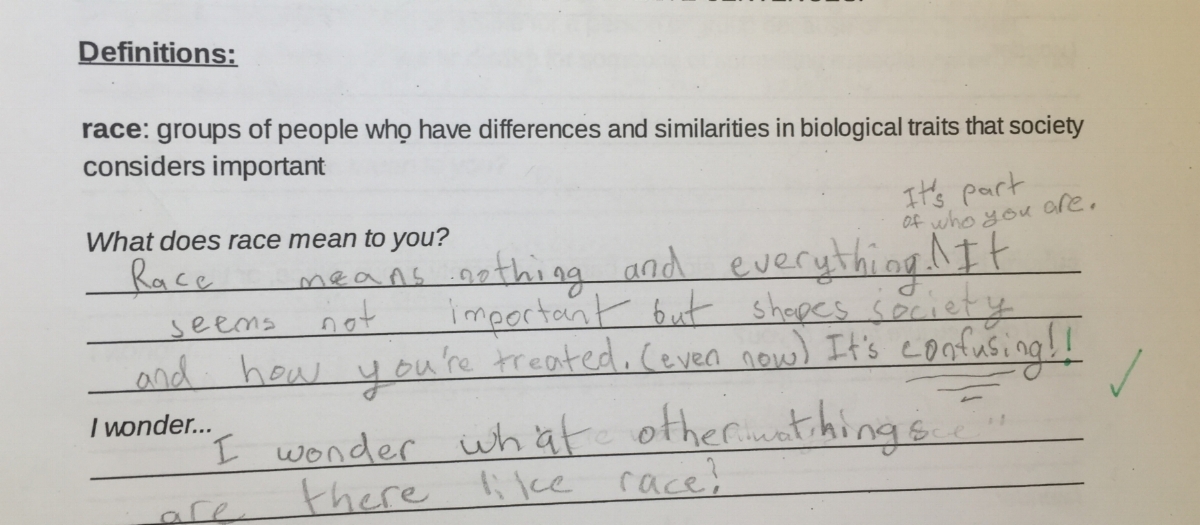Why we need to talk about race
"It's personal."
"No one has ever talked about race in front of me so I think you don't talk about it. Ever."
"My parents have only talked about it once in front of me and they were REALLY uncomfortable, so I learned you shouldn't talk about race."
Earlier this school year, we asked our students what they know about talking about race. A few representative responses are quoted above. All of our students also agreed that race is confusing and they don't know much about it. We discussed how when something is confusing or we don't know much about it, the way to learn more about it IS to talk about it, even if it is uncomfortable.
So, this week was "race week" in our classroom. We started with a drawing activity, challenging students to realize stereotypes and expectations they've internalized without realizing, and continue on to learning about institutionalized racism and learning vocabulary and explaining concepts around race.
The drawing activity consists of us reading descriptions of various celebrities (we tried to pick people the kids would know) devoid of any descriptors related to race or gender, and asking students to draw the person they visualized. We give them ONLY crayons to draw with so they are forced to choose a skin color.
One of our student's drawings.
During the reveal process when we read the descriptions and showed them a photo of the celebrity in question, we asked them to raise their hands if they drew someone female/male or black/white/etc. Some students were very nervous even to raise their hands, and insisted they "didn't draw a race." There was a lot of discomfort, nervous laughter, and awkwardly looking away. Some students said they felt "weird" about their drawings. Others only admitted they visualized or drew someone having a particular race only after another student spoke up and said she was surprised that she automatically thought in stereotypical ways.
One student reflected,
"I thought I did not believe in stereotypes, but my drawings showed me I did."
We pushed them to then reflect on WHERE they were getting these messages and images from and reminded them of our Halloween investigation and all of the outside influences on our minds! One student wrote later,
"I used to think I wasn't racist, but now I'm thinking that it is weird that my mind was already being prejudiced beause I didn't think I was."
Next, we learned about racism by watching this video. We bleeped out a curse word and gave the students an outline of the main points to fill in, as well as stopping and discussing and watching the video twice (as they noted, she talks so fast!). Students had a lot of questions about institutions and the idea of a social construct. We assured them that these are difficult concepts for adults and we would keep thinking and talking about them. For homework that night, they read a Newsela article titled "For minority students, suspensions begin in the earliest grades" for a practical application of both institutional racism and intrinsic bias.
The finished charts from our "silent conversation."
Later in the week, we had a class "silent conversation." If you haven't experienced the silent conversation set up before, you should try it and will love it! It is an amazing way to quietly and automatically build in reflection and responding to thoughts and questions of others. We wrote stereotype, prejudice, race, culture, discrimination, identity, and bias down on sheets of chart paper. Then, we modeled how to have a silent conversation on the board and asked students what they noticed. They came up with:
Be silent!
Write down your thoughts/reactions to the word on the paper.
Respond to other people's thoughts.
Show you agree with an exclamation point or you don't understand with a question mark.
As you can see from the photo above, students had thoughtful and complex responses during our silent conversation. One student reflected afterward that writing instead of having to speak up really freed her to think of what she wanted to say as no one knew it was her writing and we were all just thinking of ideas separate from who wrote or said them.
Questions and thoughts students had after our silent conversation:
"I wonder why so many people think stereotypically. Even I think stereotypically without realizing it."
"I wonder how I can detect bias in myself and fix it? Also, I wonder if people naturally have prejudice or if it is something that is taught?"
In past years, we have had to explicitly connect this learning to present day issues, as our students used to think that racism was more of a problem in the past, like slavery or legally enforced segregation. They had learned a narrative that Dr. Martin Luther King and the civil rights movement "fixed" problems relating to racism. However, in the aftermath of the recent Presidential election and with frequent news of hateful harassment since Election Day (some in nearby areas), this year they easily made the connections on their own.


